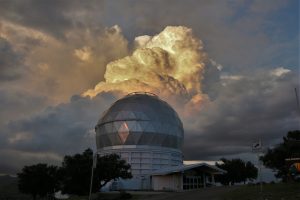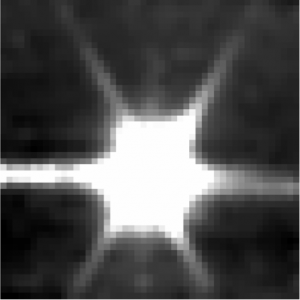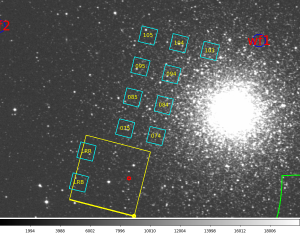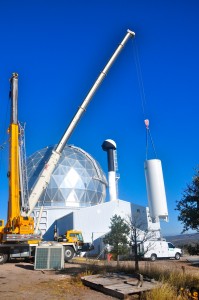It has been quiet during the day at the HET this week with day staff on holiday. If the weather clears the night staff will be plenty busy working through the queue. The current weather outlook for the week is cloudy with possible showers. Monday night we were able to do science through thin clouds and successfully collected data for many programs that do not require perfect seeing or zero cloud cover. The bulk of the science data collected in the beginning of the week has been with LRS2-B and LRS2-R. Fingers crossed the weather clears as we approach the new moon on Thursday.
Category Archives: Observing
Week of December 19th
This week has been an exciting week ramping up to science. The Board of Visitor Staff Excellence Award Winners were announced by Director Armandroff and are as follows: Henry Cantu, Angela Davis, Steve Odewahn, and Trent Peterson. Congratulations to the winners.
We are quickly moving in to science mode with the upcoming new moon. Currently this week the first half of each night is being used primarily for science with the second half used for engineering due to the moon. The weather looks to be clearing over the holiday weekend, so hopefully we will be able to collect some good data for the HET community!
The week of December 11
This week marks the first full week of the new trimester (December – March). During this period we will be observing for 2 weeks around the new moon with LRS2-B and LRS2-R and to a very limited extent the first 16 units of VIRUS for science projects from our partners. We have 27 separate projects from our 4 partners. During this first week of the new trimester we took data for 10 programs.
During the 2 weeks around the full moon we will be concentrating on engineering but we may if it does not impose any constraint on the engineering obtain a few science targets during grey and bright time.
It is good to be back online taking science data.
Week of September 19th

One of the many powerful thunderstorms that passed by us this month. This one produced hail just north of the HET.
This week we finally had a break in the stormy weather and started wave front sensor commissioning. A team from Austin came out and installed an imager and wave front sensor in the IHMP (Input Head Mounting Plate) to calibrate all other wave front sensors on the telescope. These devices once calibrated will help keep the tracker in perfect alignment with the mirror to optimize the observations we are taking for science. This will be the main focus for the next month. Hopefully the weather is more cooperative than it has been. If you would like to see a time-lapse of some of the recent storms follow this link: https://www.youtube.com/watch?v=shRD2WmPWd4
The week of July 11
Last week we reported on a incident with the HET tracker that put us in a hard skew condition and shut us down. We had recovered from that skew condition but the software issues that led to the skew had continued. This week I am happy to report that we have not only installed additional skew sensors but we have found the source of the software issues. The software teams in Austin and West Texas were able to perform a series of experiments which allowed them to isolate the problem as coming from the ethernet card inside the dSpace box. This is a very specialized ethernet card but thankfully we were able to swap out a different card for it and found that all of our TCS communications problems, hexapod faults, and loading trajectory errors have gone away. We will look into getting a spare card and send the card in to see what kind of fault occurred in the card.
With the improved tracker performance we were able to start our early science operations. We took our first science targets on the night of the 16th. Unfortunately, we are now headed towards full moon which is not the ideal time to do science targets with LRS2. However, it does give us a chance to work out any inefficiencies in our PI interface, night operations interfaces and queue tools so that we can be fully ready once we get some dark time a few days after full moon.
The week of July 4th
Two weeks ago we had a fairly serious tracker issue. While recovering from a fairly typical tracker failure, the telescope operator requested that the breaks be set but instead the tracker moved in X and generated a hard skew. This hard skew actually caused the bearing to come out of the bearing block. This occurred the day that the blogger and most of the chief engineers were going to their summer conferences. Upon the return the engineers were able to determine that no permanent damage was done to the bearings or the tracker in general. The engineering team was able to move the tracker back into the block using the tracker motors. Unfortunately, the software issues that led to the skew are still present and have not yet been sorted out. This has severely limited our ability to run trajectories for engineering or the start of early science operations.
In the mean time work continues on VIRUS enclosure 2 and with re-coating of the primary mirror segments.
The week of May 23
In the previous week the HET Board of Directors met and were generally happy with the progress being made on the HET. They are very eager for science operations to begin and have authorized the start of Early Science Operations starting July 1st. This will mean that HET member institutions will be able to submit requests to their local Telescope Allocation Committee in the coming weeks. The amount of time available will grow with time but is likely to start with 1 week per dark period. The instrument that will be available for Early Science Operations will be the new Low Resolution Spectrograph (LRS2).
In this week the HET continued with VIRUS commissioning during bright time with the addition of 7 new VIRUS units. This brings the number of spectrographs units (and IFUs) to 16. We will use these during commissioning in the coming dark run but we can already see that several of them will need some further engineering while others are very good.
The mirror team continues to swap mirrors into the array this week they swapped out 4 mirrors. The array now has an average coating age of 454 days with a swap rate of 1.7 segments/week.
The week of April 18
We are currently in bright time (near full moon) and the currently active instruments, LRS2 and VIRUS are really designed to operate in dark time (when the moon is below the horizon), thus we spent this week analyzing the data taken in the last dark run, testing and updating the telescope control software and training the night time staff to make sure all of the staff have the same skills and knowledge of the system for the upcoming dark run.
One of the problems we were having in the last dark run was a mysterious end of track due to a hexapod hitting the software limit. Further investigation has revealed that this limit is part of the natural extension of the warming tracker. As the steel structure expands from warmer temperatures we have to move the hexapods down to compensate. We also found that we had set the software limits fairly far from the limit switches so we could give ourselves plenty more room without any changes to the hardware of the telescope. This is an example of the type of tuning that we continue to have to do with the control algorithms.
Both the LRS and the VIRUS are IFU (Integral Field Unit) spectrographs, which means that one could take the spectra for each fiber and reconstruct an image of the field which was observed. Below is the very first reconstruction that we did for a VIRUS field. It was a fairly bright (8th mag) standard star. The image scale is set very wide so that we can see all of the interesting features that come from the unusual design of the HET. The six image spikes comes from the edges of the hexagonal HET segments, and the stronger spikes along the X direction come from the tracker Y superstructure.

First reconstructed IFU image from VIRUS. A very bright 8th mag standard star with the stretch set very wide to show all features.
Not long after generating this the software team was able to reconstruct a number of images for each IFU in a pointing of a globular cluster, NGC5272. Below I show a couple of examples of these.
Here is a schematic of what the current array of IFUs would look like compared to a Digitized Sky Survey Image of the field we pointed at. This is a by-product of our current setup software.
The week of August 24
While much work has continued during the day focus has begun to shift to support of night operations and commissioning. The blogger has moved back to working the night shift so updates on day operations may be second hand.
The day staff have installed the acquisition camera, pupil viewer, guide probes and Deployable Wave Front Sensors (DWFS) on the Focal Plane Assembly (FPA). In addition, they have gotten glycol lines hooked up to the VIRUS enclosures and those lines have been pressure tested. The glycol lines to the top of the telescope for cooling the electronics boxes and cameras are still on order.
The software team in Austin has been out to the telescope twice over the past few weeks to commission various aspects of the telescope and mount model. The preliminary mount model has been completed and we can now track on a star and keep constant focus and tracker induced coma through a trajectory. The DWFS will be used in the next weeks to determine the exact tip and tilt zero point to minimize the tracker induced coma and to search for any problems with the mounting of the tracker optics. This will be done on geostationary satellites which allow us to have a constant point source at infinity for long periods of time with minimal tracker motion. We have confirmed that we can acquire these geostationary satellites on the Acquisition camera.
The night staff is also in the process of commissioning the guide probes. We have been able to obtain star fields in both guide probes and the acquisition camera at the same time. With this data and probably a few more similar data sets at different guide probe positions we will be able to set the zero points to pointing with the guide probes.
While we continue to work out small problems and inefficiencies with the tracker electronics and telescope control software overall the telescope is coming along well and some ways is far more impressive than the old HET.
The week of Oct 27
The contractors continue to work through the Remote Thermal Area punch list including
repairing sheet rock, cleaning up building penetrations, clean up material and reinstalling the roof gutter down spouts. We also have contractors out working on the balance of the in-line fans for the strip and wash duct and the K-hut duct.
We received another shipment of VIRUS Platforms/Ladders;
it contained the platform side supports for both VIRUS right and VIRUS left and a top work platform for one of the VIRUS enclosures. We have been doing test fits of these enclosures in preparation for installing all of them in two weeks.
John Good, mechanical engineer from Austin, was here for the last two weeks to work with the laser tracker. The first days were spent confirming the current mount model then making refinements to it. We now believe we have the best mount model that can be obtained with this laser tracker.
Some work at night was done this week. We went on sky to test the mount model, see if the position of the Celestron Alignment Telescope (CAT) was good enough for future testing. We found the RA, DEC and rho offsets are now working and that the center of rotation falls at the corner of the CAT. Tests of the geosynchronous satellite tracking software within TCS suggests that it is probably working although the CAT is just to small to see these 11-13th mag objects. We believe we are sufficiently ready for any future metrology tests. With this alignment out of the way we put the CCAS tower mirror alignment system back together and have confirmed that all of the components are well aligned and working with alignment to better than 0.5″.
Work in the spectrograph room continues. One of our TOs finished the touch-ups required after the contractors scratched the paint in the area where the HPF enclosure will go. With that done we are ready for the HPF enclosure to arrive next week. We also received the mounts for the HRS sensors. These will be part of the system that monitors and controls the HRS temperature to improve performance in velocity stability.
The really big news is that we installed the large liquid nitrogen tank behind the K-hut. This required days of preparation and coordination between the HET, Crane services, Praxair and Midwest Cryo teams. The two cranes made quick work of putting the crane in place and by lunch the tank was bolted down. In the two following days nearly all of the plumbing to the K-hut vaporizer and the filling location were installed.




